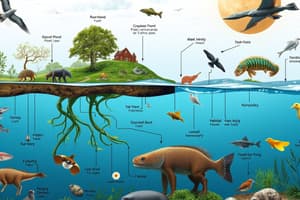Podcast
Questions and Answers
What does the Trophic State Index (T.S.I) help to determine?
What does the Trophic State Index (T.S.I) help to determine?
- The depth of a lake
- The number of fish in a lake
- The temperature of the pond
- The quality of water in lakes or ponds (correct)
Human activity such as draining the pond can support the successional cycle.
Human activity such as draining the pond can support the successional cycle.
False (B)
What can the Trophic State Index (T.S.I) be used for?
What can the Trophic State Index (T.S.I) be used for?
To compare changes in lake quality over years or between different lakes.
Draining and dredging the pond can disrupt the __________ cycle.
Draining and dredging the pond can disrupt the __________ cycle.
Match the following activities with their potential impact on lakes or ponds:
Match the following activities with their potential impact on lakes or ponds:
Flashcards are hidden until you start studying
Study Notes
Trophic State Index (T.S.I)
- The T.S.I is a measurement that allows for comparison between different lakes and over time.
- It utilizes three indicators:
- Secchi disk depth (SD): This measures the depth of water seen with a Secchi disk.
- Total phosphorus concentration (TP): The amount of phosphorus at the lake's surface.
- Chlorophyll a concentration (chl a): The amount of chlorophyll a at the lake's surface.
- It is recommended to use average values taken over a summer period.
- The T.S.I calculation for secchi disk depth (SD) is: T.S.I = 60 – 14.41 (ln SD), with SD being the value in meters.
- The T.S.I calculation for Chlorophyll a concentration is: T.S.I = 9.81(ln chl a) + 30.6, with chl a being the value in µg/L.
- Human activities, such as draining and dredging, can disrupt the natural successional cycle of a pond.
Studying That Suits You
Use AI to generate personalized quizzes and flashcards to suit your learning preferences.




